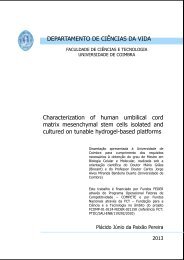role of th1 and th17 cd4+ t cell subsets in the pathogenesis of ...
role of th1 and th17 cd4+ t cell subsets in the pathogenesis of ...
role of th1 and th17 cd4+ t cell subsets in the pathogenesis of ...
Create successful ePaper yourself
Turn your PDF publications into a flip-book with our unique Google optimized e-Paper software.
a monoclonal antibody was found to be beneficial <strong>in</strong> acute EAE (H<strong>of</strong>stetter et al., 2005)<br />
<strong>and</strong> block<strong>in</strong>g IL‐23 function with anti‐IL‐23p19‐specific antibodies <strong>in</strong> EAE sick mice<br />
<strong>in</strong>hibited multiple <strong>in</strong>flammatory pathways functions such as serum levels <strong>of</strong> IL‐17 <strong>and</strong><br />
CNS expression <strong>of</strong> IFNγ <strong>and</strong> IL‐17 (Chen et al., 2006). Also, IL‐17 deficient mice exhibited<br />
delayed EAE onset <strong>and</strong> adoptive transfer <strong>of</strong> IL‐17 deficient CD4+ T <strong>cell</strong>s, which carried<br />
an <strong>in</strong>creased number <strong>of</strong> IFNγ‐produc<strong>in</strong>g <strong>cell</strong>s, <strong>in</strong>efficiently were able to <strong>in</strong>duce EAE <strong>in</strong><br />
recipient mice (Komiyama et al., 2006). IL‐27 is a cytok<strong>in</strong>e that suppresses Th17 <strong>cell</strong>s<br />
<strong>and</strong> IL‐27R alpha‐deficient mice were also found to be hypersusceptible to EAE (Batten<br />
et al., 2006). In <strong>the</strong> absence <strong>of</strong> TGFβ signal<strong>in</strong>g, mice were found to be deficient <strong>in</strong> Th17<br />
<strong>cell</strong>s <strong>and</strong> resistant to EAE immunization (Veldhoen et al., 2006c). More recently, <strong>the</strong><br />
restriction <strong>of</strong> IL‐23 receptor deficiency to def<strong>in</strong>ed <strong>cell</strong> populations <strong>in</strong> vivo showed that<br />
Th17 <strong>cell</strong>s failed to down‐regulate IL‐2 <strong>and</strong> ma<strong>in</strong>ta<strong>in</strong> IL‐17 production, associated with<br />
less proliferation <strong>and</strong> capacity to migrate to certa<strong>in</strong> tissues (McGeachy et al., 2009),<br />
demonstrat<strong>in</strong>g <strong>the</strong> requirement <strong>of</strong> IL‐23 signal<strong>in</strong>g <strong>in</strong> <strong>the</strong> development <strong>and</strong> function <strong>of</strong><br />
Th17 <strong>cell</strong>s <strong>in</strong> autoimmunity.<br />
The observations <strong>in</strong>volv<strong>in</strong>g <strong>the</strong> Th17 ra<strong>the</strong>r <strong>the</strong> Th1 <strong>cell</strong>s pathogenicity <strong>in</strong> EAE might<br />
comes might be expla<strong>in</strong>ed by some <strong>in</strong>terest<strong>in</strong>g studies. First, <strong>the</strong> study <strong>of</strong> <strong>the</strong> <strong>role</strong> <strong>of</strong><br />
pertussis tox<strong>in</strong> as an immune adjuvant <strong>in</strong> active EAE demonstrated that pertussis tox<strong>in</strong><br />
<strong>in</strong>hibits <strong>the</strong> development <strong>of</strong> Tregs <strong>and</strong> <strong>in</strong>duces IL‐17‐produc<strong>in</strong>g CD4 <strong>cell</strong>s (Chen et al.,<br />
2007). Additionally, mycobacteria <strong>and</strong> zymosan, a <strong>cell</strong> wall component <strong>of</strong><br />
Saccharomyces cerevisiae, when emulsified with MOG <strong>and</strong> <strong>in</strong>complete Freund’s<br />
adjuvant for immunization potentiate Th17 <strong>cell</strong> differentiation (Veldhoen et al., 2006c).<br />
Therefore, <strong>the</strong> active EAE model might be already pre‐conditioned to a Th17 response,<br />
mask<strong>in</strong>g <strong>the</strong> true <strong>role</strong> <strong>of</strong> T <strong>cell</strong>s responses <strong>in</strong> CNS autoimmunity.<br />
O<strong>the</strong>r studies suggested <strong>the</strong> <strong>in</strong>volvement <strong>of</strong> cytok<strong>in</strong>es <strong>and</strong> transcription factors<br />
affect<strong>in</strong>g both Th1 <strong>and</strong> Th17 populations, previously associated with only one T <strong>cell</strong><br />
subset. MOG‐specific T <strong>cell</strong>s from IL23p19KO mice, found to be highly deficient not only<br />
<strong>in</strong> <strong>the</strong> production <strong>of</strong> IL‐17A but also <strong>of</strong> IFNγ, <strong>in</strong>duced EAE with delayed onset <strong>and</strong> much<br />
lower severity when transferred to WT recipient mice, <strong>in</strong>dicat<strong>in</strong>g a critical <strong>role</strong> <strong>of</strong> IL‐23<br />
<strong>in</strong> development <strong>of</strong> encephalitogenic T <strong>cell</strong>s, towards both Th1 <strong>and</strong> Th17 pathways<br />
(Thakker et al., 2007). Notwithst<strong>and</strong><strong>in</strong>g, ano<strong>the</strong>r work focused on <strong>the</strong> suppression <strong>of</strong> T‐<br />
bet described an amelioration <strong>of</strong> EAE, not only by limit<strong>in</strong>g <strong>the</strong> differentiation <strong>of</strong> auto‐<br />
36

















